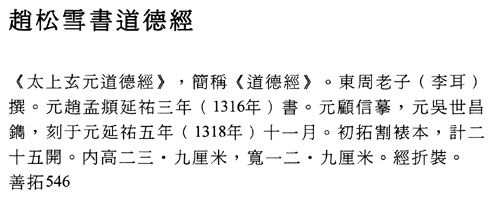 |
|
|
 |
The Scripture of
the Way and Its Virtues, in the Calligraphy of Zhao Mengfu Yuan
dynasty (1279�1368), Yanyou period (1314�20) Calligraphy
by Zhao Mengfu (1254�1322) in 18 or 19 small regular-script characters per
column, dated 1316; text copied by Gu Xin (act. late 13th�early 14th century)
and engraved by Wu Shichang (act. late 13th�early 14th century) in 1318 Album
of 50 leaves, ink rubbed on yellow paper, accordion-style mounting between top
and bottom wooden boards; overall dimensions of album: 31.7 x 17.0 x 2.6 cm;
each leaf: approx. 31.6 x 17.0 cm; each rubbing panel: approx. 23.9 x 12.9 cm Date
of rubbing not given, probably late Yuan dynasty (1279�1368) Inventory number: Shanta 546 The
Daode
jing (The Scripture of the Way and Its Virtues), a canonical text
associated with philosophical Daoism, is relatively concise with about 5,000
characters in 81 short aphoristic sections. Zhao
Mengfu was also one of the preeminent calligraphers and painters of the Yuan
dynasty and is known to have made several complete transcriptions of the Daode jing
in his exquisite small xiaokai (regular-script) calligraphy.� The piece he executed in 1316 was traced by
Gu Xin and engraved by Wu Shichang on a set of 10 stone tablets two years
later.� They were housed in the White
Cloud Monastery, the preeminent Daoist abbey of Beijing, where the rubbings in
this album were presumably made between 1318 and the fall of the Yuan dynasty
in 1368.� The stones incised with Zhao
Mengfu's writing are of considerable inscriptional and historical importance as
one of eleven extant engravings of the Daode jing made between the early eighth
and early fourteenth centuries that can be used as comparative material with
transmitted versions of this canonical text in other media. |
 |